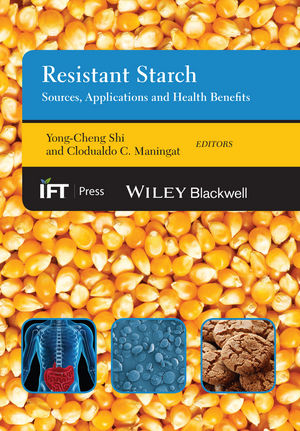
Resistant Starch
Wiley-Blackwell (Verlag)
978-0-8138-0951-9 (ISBN)
- Titel z.Zt. nicht lieferbar
- Versandkostenfrei innerhalb Deutschlands
- Auch auf Rechnung
- Verfügbarkeit in der Filiale vor Ort prüfen
- Artikel merken
Resistant Starch: Sources, Applications and Health Benefits covers the intrinsic and extrinsic sources of resistant starch in foods, and compares different methods of measuring resistant starch and their strengths and limitations. Applications in different food categories are fully covered, with descriptions of how resistant starch performs in bakery, dairy, snack, breakfast cereals, pasta, noodles, confectionery, meat, processed food and beverage products.
Yong-Chen Shi, PhD, Associate Professor and Director, Carbohydrate Polymers - Technology and Product Innovation Department of Grain Science and Industry, Kansas State University. Ody Maningat, PhD, Vice President, R&D and Technical Services, Manildra Group, USA.
Preface xvii About the Editors xix
List of Contributors xxi
Acknowledgements xxv
1 Starch Biosynthesis in Relation to Resistant Starch 1
Geetika Ahuja, Sarita Jaiswal and Ravindra N. Chibbar
1.1 Introduction 1
1.1.1 Starch components 1
1.1.2 Resistant starch 2
1.2 Factors Affecting Starch Digestibility 3
1.3 Starch Biosynthesis 4
1.4 Starch Biosynthesis in Relation to RS 6
1.4.1 ADP-glucose pyrophosphorylase (AGPase) 6
1.4.2 Starch synthases (SS) 6
1.4.3 Starch branching enzymes (SBE) 11
1.4.4 Starch debranching enzymes (DBE) 13
1.5 Concluding Remarks 13
Acknowledgements 15
References 15
2 Type 2 Resistant Starch in High-Amylose Maize Starch and its Development 23
Hongxin Jiang and Jay-lin Jane
2.1 Introduction 23
2.2 RS Formation in High-Amylose Maize Starch 28
2.3 RS Formation During Kernel Development 29
2.4 Elongated Starch Granules of High-Amylose Maize Starch 31
2.4.1 Structures of elongated starch granules 31
2.4.2 Formation of elongated starch granules 33
2.4.3 Location of RS in the starch granule 35
2.5 Roles of High-Amylose Modifier (HAM) Gene in Maize ae-Mutant 36
2.6 Conclusions 37
References 38
3 RS4-Type Resistant Starch: Chemistry, Functionality and Health Benefits 43
Clodualdo C. Maningat and Paul A. Seib
3.1 Introduction 43
3.2 Historical Account of Starch Indigestibility 44
3.3 Starch Modification Yielding Increased Resistance to Enzyme Digestibility 47
3.3.1 Cross-linked RS4 starches 50
3.3.2 Substituted RS4 starches 54
3.3.3 Pyrodextrinized RS4 Starches 56
3.4 Physicochemical Properties Affecting Functionality 57
3.5 Physiological Responses and Health Benefits 60
3.6 Performance in Food and Beverage Products 65
3.7 Conclusions and Future Perspectives 68
References 68
4 Novel Applications of Amylose-Lipid Complex as Resistant Starch Type 5 79
Jovin Hasjim, Yongfeng Ai and Jay-lin Jane
4.1 Introduction 79
4.2 Enzyme Digestibility of Amylose-Lipid Complex 80
4.2.1 Effects of lipid structure on the enzyme resistance of amylose-lipid complex 81
4.2.2 Effects of the crystalline structure on the enzyme resistance of amylose-lipid complex 82
4.2.3 Effects of amylose-lipid complex on the enzyme resistance of granular starch 82
4.3 Production of Resistant Granular Starch Through Starch-Lipid Complex Formation 83
4.3.1 Effects of fatty-acid structure on the RS content 83
4.3.2 Effects of debranching on the RS content 85
4.4 Applications of the RS Type 5 86
4.5 Health Benefits of RS Type 5 87
4.5.1 Glycemic and insulinemic control 87
4.5.2 Colon cancer prevention 89
4.6 Conclusion 91
References 92
5 Digestion Resistant Carbohydrates 95
Annette Evans
5.1 Introduction 95
5.2 Starch Digestion 95
5.3 Physical Structures of Starch 97
5.3.1 Starch helices 98
5.3.2 Crystalline structures 99
5.3.3 Starch granule structure 99
5.4 Resistant Starch due to Physical Structure 100
5.5 Molecular Structure of Starch 102
5.6 Enzyme Resistance due to Molecular Structure 103
5.7 Conclusion 106
References 106
6 Slowly Digestible Starch and Health Benefits 111
Genyi Zhang and Bruce R. Hamaker
6.1 Introduction 111
6.2 SDS and Potential Beneficial Health Effects 112
6.2.1 Potential health benefit of SDS relative to RDS 113
6.3 The Process of Starch Digestion 115
6.3.1 Enzyme action 115
6.4 Structural and Physiological Fundamentals of SDS 116
6.4.1 Physical or food matrix structures related to SDS 117
6.4.2 Starch chemical structures leading to SDS 118
6.4.3 Other food factors that decrease digestion rate 120
6.4.4 Physiological control of food motility 121
6.5 Application-Oriented Strategies to Make SDS 121
6.5.1 Starch-based ingredients 121
6.5.2 SDS generation in a food matrix 122
6.6 Considerations 123
References 123
7 Measurement of Resistant Starch and Incorporation of Resistant Starch into Dietary Fibre Measurements 131
Barry V. McCleary
7.1 Introduction 131
7.2 Development of AOAC Official Method 2002.02 133
7.3 Development of an Integrated Procedure for the Measurement of Total Dietary Fibre 136
References 142
8 In Vitro Enzymatic Testing Method and Digestion Mechanism of Cross-linked Wheat Starch 145
Radhiah Shukri, Paul A. Seib, Clodualdo C. Maningat, and Yong-Cheng Shi
8.1 Introduction 145
8.2 Materials and Methods 148
8.2.1 Materials 148
8.2.2 General methods 148
8.2.3 Conversion of CL wheat starch to phosphodextrins and 31PNMR spectra of the phosphodextrins 148
8.2.4 Digestibility of CL wheat starch 149
8.2.5 Thermal properties 150
8.2.6 Microscopic observation 150
8.2.7 Scanning electron microscope (SEM) 150
8.2.8 Statistical analysis 150
8.3 Results and Discussion 151
8.3.1 Effects of a-amylase/amyloglucosidase digestion on P content and chemical forms of the phosphate esters on starch 151
8.3.2 Thermal properties 152
8.3.3 Starch granular morphology before and after enzyme digestion 153
8.3.4 Digestibility 160
8.4 Conclusions 162
8.5 Acknowledgements 163
8.6 Abbreviations Used in This Chapter 163
References 163
9 Biscuit Baking and Extruded Snack Applications of Type III Resistant Starch 167
Lynn Haynes, Jeanny Zimeri and Vijay Arora
9.1 Introduction 167
9.2 Thermal Characteristics of Heat-Shear Stable Resistant Starch Type III Ingredient 168
9.3 Application to Biscuit Baking: Cookies 172
9.4 Cracker Baking 175
9.5 Extruded Cereal Application 178
9.5.1 Preparation of extruded RTE cereal and analysis 179
References 189
10 Role of Carbohydrates in the Prevention of Type 2 Diabetes 191
Thomas M.S. Wolever
10.1 Introduction 191
10.2 Background 191
10.2.1 Definition of diabetes 191
10.2.2 Types of diabetes 192
10.2.3 Complications of diabetes 192
10.2.4 Prevalence of diabetes 192
10.2.5 Risk factors for type 2 diabetes 193
10.3 Carbohydrates and Risk of Type 2 Diabetes 193
10.3.1 Markers of carbohydrate quality 193
10.4 Pathogenesis of Type 2 Diabetes 195
10.5 Effect of Altering Source or Amount of Dietary Carbohydrate on Insulin Sensitivity, Insulin Secretion and Disposition Index 197
10.6 Mechanisms by Which Low-GI Foods Improve Beta-Cell Function 199
10.6.1 Glucose toxicity 199
10.6.2 Reduced serum free fatty acids (FFA) 200
10.6.3 Increased GLP-1 secretion 201
10.7 Conclusions 202
References 202
11 Resistant Starch on Glycemia and Satiety in Humans 207
Mark D. Haub
11.1 Introduction 207
11.2 Diet and Resistant Starch 208
11.3 Resistant Starch and Insulin Sensitivity 209
11.4 Current Theoretical Mechanism 209
11.5 Satiety 211
11.6 Fermentation and Gut Microbiota 212
11.7 Effect of RS Type 212
11.8 Summary 213
References 213
12 The Acute Effects of Resistant Starch on Appetite and Satiety 215
Caroline L. Bodinham and M. Denise Robertson
12.1 Appetite Regulation 215
12.2 Measurement of Appetite in Humans 216
12.3 Proposed Mechanisms for an Effect of Resistant Starch on Appetite 217
12.4 Rodent Data 218
12.5 Human Data 221
References 225
13 Metabolic Effects of Resistant Starch 229
Martine Champ
13.1 Fermentation of RS and Its Impact on Colonic Metabolism 230
13.2 Resistant Starch, Glycemia, Insulinaemia and Glucose Tolerance 235
13.3 RS Consumption and Lipid Metabolism 236
13.4 RS Consumption, GIP, GLP-1 and PYY Secretion 238
13.5 RS Consumption, Satiety and Satiation and Fat Deposition 239
13.6 Conclusion 242
References 244
14 The Microbiology of Resistant Starch Fermentation in the Human Large Intestine: A Host of Unanswered Questions 251
Harry J. Flint
14.1 Introduction 251
14.2 Identifying the Major Degraders of Resistant Starch in the Human GI Tract 252
14.2.1 The human colonic microbiota 252
14.2.2 Cultural studies 252
14.2.3 16S rRNA-based studies 253
14.3 Systems for Starch Utilization in Gut Bacteria 254
14.3.1 Bacteroides spp. 255
14.3.2 Bifidobacterium spp. 255
14.3.3 Lachnospiraceae - Roseburia spp., Eubacterium rectale and relatives 256
14.3.4 Ruminococcaceae 256
14.4 Metagenomics 256
14.5 Factors Influencing Competition for Starch as a Growth Substrate 257
14.6 Metabolite Cross-Feeding 258
14.7 Impact of Dietary Resistant Starch upon Colonic Bacteria and Bacterial Metabolites in Humans 259
14.8 Conclusions and Future Prospects 260
Acknowledgements 262
References 262
15 Colon Health and Resistant Starch: Human Studies and Animal Models 267
Suzanne Hendrich, Diane F. Birt, Li Li and Yinsheng Zhao
15.1 RS Classification 267
15.2 RS and Colon Health: Overview 267
15.3 RS, Gut Microbes and Microbial Fermentation 268
15.3.1 RS and laxation 269
15.3.2 RS, IBS and diverticulosis 270
15.3.3 RS and IBD 270
15.3.4 RS and colon cancer risk – human studies 271
15.4 Colon Cancer Prevention – Animal Models 272
15.5 Conclusions 275
References 275
Index 279
| Erscheint lt. Verlag | 11.11.2013 |
|---|---|
| Reihe/Serie | Institute of Food Technologists Series |
| Verlagsort | Hoboken |
| Sprache | englisch |
| Maße | 161 x 236 mm |
| Gewicht | 667 g |
| Themenwelt | Sachbuch/Ratgeber ► Gesundheit / Leben / Psychologie ► Ernährung / Diät / Fasten |
| Technik | |
| Weitere Fachgebiete ► Land- / Forstwirtschaft / Fischerei | |
| ISBN-10 | 0-8138-0951-7 / 0813809517 |
| ISBN-13 | 978-0-8138-0951-9 / 9780813809519 |
| Zustand | Neuware |
| Haben Sie eine Frage zum Produkt? |
aus dem Bereich


